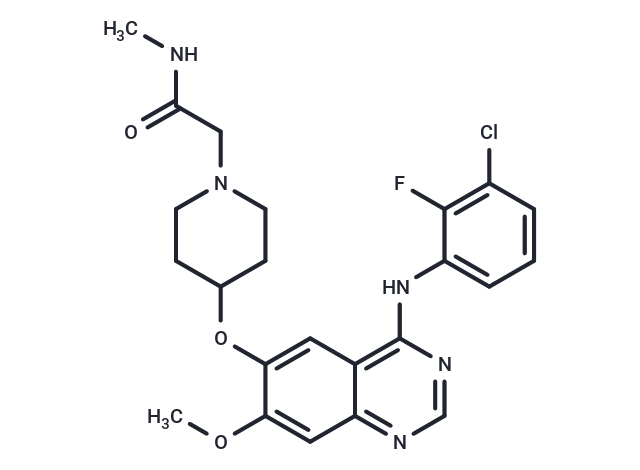Shopping Cart
Remove All Your shopping cart is currently empty
Your shopping cart is currently empty
Sapitinib (AZD-8931) , a reversible, ATP competitive inhibitor of EGFR(IC50=4 nM), ErbB2(IC50=3 nM) and ErbB3(IC50=4 nM), is more effective over Gefitinib or Lapatinib against NSCLC cell, 100-fold more specific for the ErbB family over MNK1 and Flt.

| Pack Size | Price | USA Warehouse | Global Warehouse | Quantity |
|---|---|---|---|---|
| 2 mg | $32 | In Stock | In Stock | |
| 5 mg | $52 | In Stock | In Stock | |
| 10 mg | $79 | In Stock | In Stock | |
| 25 mg | $113 | In Stock | In Stock | |
| 50 mg | $169 | In Stock | In Stock | |
| 100 mg | $252 | In Stock | In Stock | |
| 1 mL x 10 mM (in DMSO) | $54 | In Stock | In Stock |
| Description | Sapitinib (AZD-8931) , a reversible, ATP competitive inhibitor of EGFR(IC50=4 nM), ErbB2(IC50=3 nM) and ErbB3(IC50=4 nM), is more effective over Gefitinib or Lapatinib against NSCLC cell, 100-fold more specific for the ErbB family over MNK1 and Flt. |
| Targets&IC50 | ERB3:4 nM, ErbB2:3 nM, EGFR:4 nM |
| In vitro | Sapitinib shows different potency to NSCLC and SCCHN cell lines. Sapitinib has high sensitivity to PC-9 cells (EGFR activating mutation) with GI50 of 0.1 nM and low activity to NCI-1437 cells with GI50 above 10 μM. Sapitinib exhibits more potency against phospho-EGFR, phospho-erbB2 and phospho-erbB3 than either lapatinib or gefitinib in PE/CA-PJ41, PE/CA-PJ49, DOK and FaDu cells. [1] |
| In vivo | Sapitinib reveals antitumor activity in BT474c, Calu-3, LoVo, FaDu and PC-9 xenografts. Sapitinib could reduce p-Akt, Ki67 expression and p-ERK in BT474c xenografts following acute treatment. Sapitinib also causes induction of the M30 apoptosis marker. Furthermore, Sapitinib shows greater proapoptotic effect compared with gefitinib and lapatinib in LoVo xenografts. [1] |
| Kinase Assay | Isolated kinase assays: The intracellular kinase domains of human EGFR and erbB2 are cloned and expressed in the baculovirus/Sf21 system. The inhibitory activity of AZD8931 is determined with ATP at Km concentrations (0.4 mM for erbB2 and 2 mM for EGFR) using the ELISA method. |
| Cell Research | To determine the antiproliferative activity against cell lines grown in vitro, AZD8931 is tested in a panel of NSCLC and SCCHN cell lines. Cells are incubated for 96 hours with AZD8931 (0.001-10 μM). Viable cell number is determined by 4 hours of incubation with MTS Colorimetric Assay reagent and absorbance measured at 490 nm on a spectrophotometer. (Only for Reference) |
| Synonyms | AZD-8931 |
| Molecular Weight | 473.93 |
| Formula | C23H25ClFN5O3 |
| Cas No. | 848942-61-0 |
| Smiles | CNC(=O)CN1CCC(CC1)Oc1cc2c(Nc3cccc(Cl)c3F)ncnc2cc1OC |
| Relative Density. | 1.339 g/cm3 |
| Storage | Powder: -20°C for 3 years | In solvent: -80°C for 1 year | Shipping with blue ice/Shipping at ambient temperature. | ||||||||||||||||||||||||||||||
| Solubility Information | Ethanol: < 1 mg/mL (insoluble or slightly soluble) H2O: < 1 mg/mL (insoluble or slightly soluble) DMSO: 38 mg/mL (80.18 mM), Sonication is recommended. | ||||||||||||||||||||||||||||||
| In Vivo Formulation | 10% DMSO+40% PEG300+5% Tween 80+45% Saline: 2 mg/mL (4.22 mM), Sonication is recommended. Please add the solvents sequentially, clarifying the solution as much as possible before adding the next one. Dissolve by heating and/or sonication if necessary. Working solution is recommended to be prepared and used immediately. The formulation provided above is for reference purposes only. In vivo formulations may vary and should be modified based on specific experimental conditions. | ||||||||||||||||||||||||||||||
Solution Preparation Table | |||||||||||||||||||||||||||||||
DMSO
| |||||||||||||||||||||||||||||||
| Size | Quantity | Unit Price | Amount | Operation |
|---|

Copyright © 2015-2025 TargetMol Chemicals Inc. All Rights Reserved.